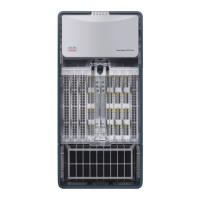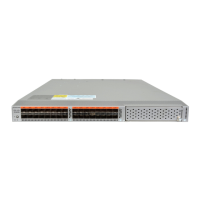378
Cisco Nexus 3548 Switch NX-OS Unicast Routing Command Reference
OL-27852-01
Chapter Unicast Routing Commands
timers lsa-group-pacing (OSPF)
timers lsa-group-pacing (OSPF)
To change the interval at which Open Shortest Path First (OSPF) link-state advertisements (LSAs) are
collected into a group and refreshed, checksummed, or aged, use the timers lsa-group-pacing
command. To return to the default, use the no form of this command.
timers lsa-group-pacing seconds
no timers lsa-group-pacing
Syntax Description
Command Default The default interval for this command is 240 seconds. OSPF LSA group pacing is enabled by default.
Command Modes Router configuration mode
VRF configuration mode
Command History
Usage Guidelines Use this command to control the rate at which LSA updates occur and reduce the high CPU or buffer
utilization that can occur when an area is flooded with a very large number of LSAs. The default settings
for OSPF packet pacing timers are suitable for the majority of OSPF deployments. Do not change the
packet pacing timers unless you have tried all other options to meet OSPF packet flooding requirements.
You should try summarization, stub area usage, queue tuning, and buffer tuning before changing the
default flooding timers. There are no guidelines for changing timer values; each OSPF deployment is
unique and should be considered on a case-by-case basis.
Cisco NX-OS groups the periodic refresh of LSAs to improve the LSA packing density for the refreshes
in large topologies. The group timer controls the interval used for group refreshment of LSAs; however,
this timer does not change the frequency that individual LSAs are refreshed (the default refresh rate is
every 30 minutes).
The duration of the LSA group pacing is inversely proportional to the number of LSAs that the router is
handling. For example, if you have about 10,000 LSAs, you should decrease the pacing interval. If you
have a very small database (40 to 100 LSAs), you should increase the pacing interval to 10 to 20 minutes.
This command requires the LAN Enterprise Services license.
Examples This example shows how to configure OSPF group packet-pacing updates between LSA groups to occur
in 60-second intervals for OSPF routing process 1:
switch# configure terminal
switch(config)# router ospf 1
seconds Time (in seconds) in the interval in which LSAs are grouped and refreshed,
checksummed, or aged. The range is from 1 to 1800 seconds. The default value
is 240 seconds.
Release Modification
5.0(3)A1(1) This command was introduced.
